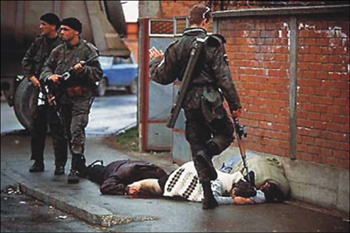Chapter 19
National Sovereignty
"It may well be that under international law as presently constituted, a regime can systematically brutalize and oppress its people and there is nothing anyone can do, when dialogue, diplomacy and even sanctions fail, unless it comes within the definition of a humanitarian catastrophe…
This may be the law, but should it be?"
—Prime Minister Tony Blair [1]
National sovereignty is the exclusive right of a government, or of its people (as in a democracy), or an individual (as in a monarchy) to exercise supreme authority over itself. In the current international system, the nation-state is the highest level of government. Its decisions cannot be overruled by a higher authority. The principle of national sovereignty seems to be an inseparable and timeless element of our reality; however it is a relatively recent concept in recorded history.
National sovereignty leaves open to question exactly what a nation's motives are, whether it is protecting its interests or expanding them, and whether a nation's means of protecting its interests and the degree of force it exerts are appropriate and proportional. The biggest failing of national sovereignty is that it does not allow international law to settle disputes between nations.
Perhaps some of the best examples of flaws inherent in the doctrine of national sovereignty are in controlling wars, which are considered civil or revolutionary wars. Throughout history nearly every nation or society has experienced internal unrest. In the last century alone, forty wars have been classified as civil wars. Many more wars have been argued to be civil wars rather than international wars, such as the war in Viet Nam. Article 2 of the UN Charter prohibits the UN from intervening in the domestic jurisdiction of its Member States, except when sending peacekeeping forces. As stated previously, that comes too late to prevent warfare, genocide and ethnic cleansing.
In Rwanda an estimated 1,000,000 Hutus and Tutsis murdered each other in the mid 1990s while the UN sat on the sidelines. From 1983 to the present, the Sudanese government permitted Janjaweed Islamic militants to kill 2,000,000 Christians and Animists in its southern and Darfur regions, displacing 5,000,000 others.
The Bosnian conflict (1992 - 1995) saw some of the harshest fighting and worst massacres in Europe since World War II. Former President Slobodan Milosevic was responsible for genocidal atrocities in Kosovo, Croatia and Bosnia. In just one small town, Srebrenica, the Serbs systematically murdered 7,800 Bosnian Muslim, Bosnian Croat and other non-Serb men, women and children. The Serbs expelled over 1,000,000 people from their homes.

Serbian commando kicks bodies of Muslims that were just killed.
April 1992. Photo by Ron Haviv.
Source: United States Holocaust Memorial Museum
Cambodian holocaust survivor, Dith Pran, and New York Times correspondent, Sydney Schanberg, covered the fall of the capital Phnom Penh and the civil war in Cambodia after Americans and their Cambodian dependents were evacuated. Their story was portrayed in the award winning movie, The Killing Fields.
On April 17th, 1975 the Khmer Rouge, a communist guerrilla group led by Pol Pot, took power in Phnom Penh, the capital of Cambodia. During their rule, it is estimated that 2 million Cambodians [30% of the population], died by starvation, torture or execution.
The Khmer Rouge banned all institutions, including stores, banks, hospitals, schools, religion, and the family. Everyone was forced to work 12 - 14 hours a day, every day. Children were separated from their parents to work in mobile groups or as soldiers. People were fed one watery bowl of soup with a few grains of rice thrown in. The Khmer Rouge left ten million landmines in the ground, one for every person in Cambodia.
[1] "Special Reports," The Guardian, May 3, 2004, politics.guardian.co.uk/iraq/story/0,12956,1162991,00.html.